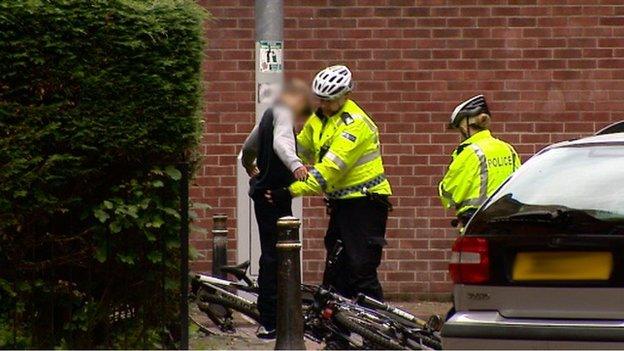Stop-and-search: Has much changed since 2014?
- Published

The issue of Police Scotland stop-and-search is back in the spotlight as figures show more than 3,000 children were subject to the tactic in the last 15 months. So what has changed in the last five years?

The lyrics may have changed but the tune it seems has not.
In 2014, we told the story that thousands of children were stopped and searched by police.
Police Scotland said at the time that the controversial tactic had helped with the reduction of violence and anti-social behaviour.
But the perception that the force was being set targets, external by the then chief constable Sir Stephen House would not go away.
The subject was put under scrutiny at Holyrood and more stories flowed into the public domain, including the one about the lost stop-and-search records.
At a Scottish Parliament committee in 2015, Police Scotland admitted it lost 20,000 stop-and-search records because "someone pressed the wrong button". It was only after admitting that that the police service started proactively publishing stop-search records online.
Consensual searches were soon abolished, and a new code of practice was introduced in May 2017 that stipulated that searches be intelligence-led and based on "reasonable grounds".
But fast forward to the present day, and it seems little has in fact changed.
Data for the last 15 months reveals that 3,172 children under 15-years-old, external have been stopped and searched.
That's about seven a day.
So if - as the new code of practice stipulated - these searches were indeed intelligence-led, then why did 62% of them not yield any results?
Interestingly, of 4,1029 searches of 18 year-olds and older, 58% were negative.
Blades and firearms
So, diving into this data, what else can been seen?
Four 15-year-old boys were given "intimate" strip searches - two of which were negative searches. We don't know if these were conducted in line with the code of practice, external, namely by an officer of the same sex, in the presence of a responsible adult, and in a private location.
392 children were searched for bladed and blunt weapons with 80% of those searches being unsuccessful.
Receipts for stop-searches were not issued to children in a third of these interactions. This would include information on the individual's right to complain about the search, and how to make a complaint.
Despite these continuing issues, there's no doubt that this tactic, if applied correctly, produces positive finds.
The data shows us that:
45 children were found to be carrying bladed instruments.
Two boys - one of them just 11-years-old - were found carrying firearms.
Two 14-year-old boys were found to be in possession of Class B drugs.
But moving forward it could be argued that further scrutiny is needed as to why many intelligence-led searches - and not just of children - are bearing no fruit.
- Published15 October 2019
